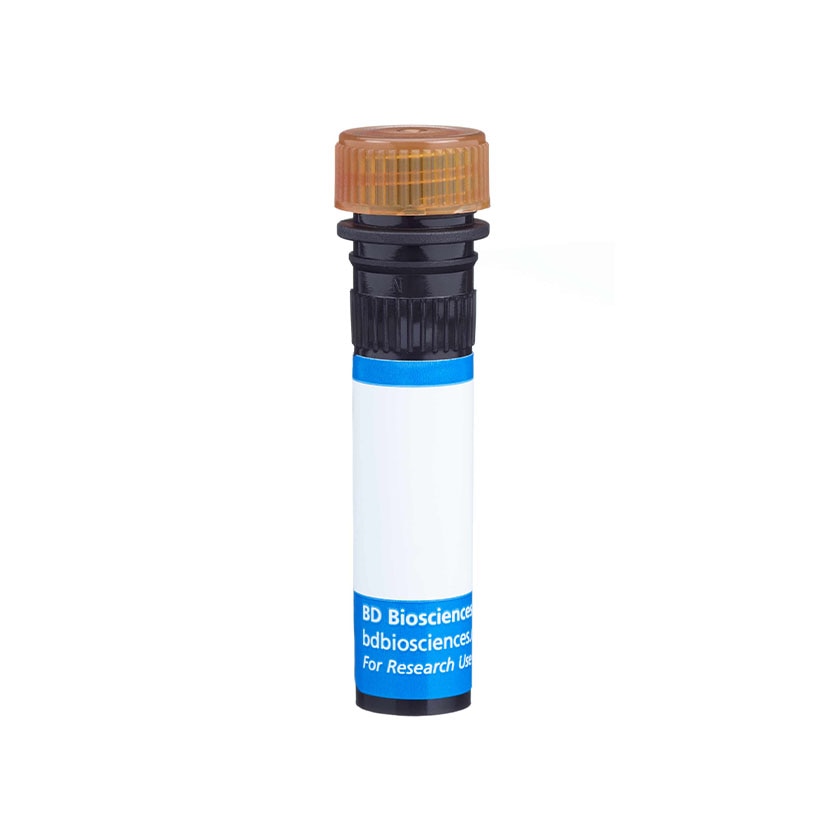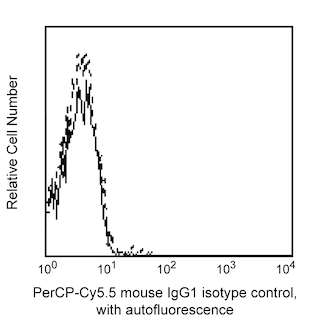Old Browser
Looks like you're visiting us from {countryName}.
Would you like to stay on the current country site or be switched to your country?




Multiparameter flow cytometric analysis of HLA-E expression on human peripheral blood leucocyte populations. Human whole blood was stained with either PerCP-Cy5.5 IgG1, κ Isotype Control (Cat. No. 550795; Left Plot) or PerCP-Cy5.5 Mouse Anti-Human HLA-E antibody (Cat. No. 567438/567439; Right Plot). The erythrocytes were lysed with BD FACS™ Lysing Solution (Cat. No. 349202). A two-parameter pseudocolor density plot showing the correlated expression of HLA-E (or Ig Isotype control staining) versus side-light scatter (SSC-A) signals was derived from gated events with the forward and side-light scatter characteristics of intact leucocytes. Flow cytometry and data analysis were performed using a BD LSRFortessa™ X-20 Cell Analyzer System and FlowJo™ software.


BD Pharmingen™ PerCP-Cy5.5 Mouse Anti-Human HLA-E

Regulatory Status Legend
Any use of products other than the permitted use without the express written authorization of Becton, Dickinson and Company is strictly prohibited.
Preparation And Storage
Recommended Assay Procedures
BD® CompBeads can be used as surrogates to assess fluorescence spillover (Compensation). When fluorochrome conjugated antibodies are bound to BD® CompBeads, they have spectral properties very similar to cells. However, for some fluorochromes there can be small differences in spectral emissions compared to cells, resulting in spillover values that differ when compared to biological controls. It is strongly recommended that when using a reagent for the first time, users compare the spillover on cells and BD CompBeads to ensure that BD® CompBeads are appropriate for your specific cellular application.
Product Notices
- This reagent has been pre-diluted for use at the recommended Volume per Test. We typically use 1 × 10^6 cells in a 100-µl experimental sample (a test).
- An isotype control should be used at the same concentration as the antibody of interest.
- Source of all serum proteins is from USDA inspected abattoirs located in the United States.
- Caution: Sodium azide yields highly toxic hydrazoic acid under acidic conditions. Dilute azide compounds in running water before discarding to avoid accumulation of potentially explosive deposits in plumbing.
- Please refer to www.bdbiosciences.com/us/s/resources for technical protocols.
- Please observe the following precautions: Absorption of visible light can significantly alter the energy transfer occurring in any tandem fluorochrome conjugate; therefore, we recommend that special precautions be taken (such as wrapping vials, tubes, or racks in aluminum foil) to prevent exposure of conjugated reagents, including cells stained with those reagents, to room illumination.
- PerCP-Cy5.5–labelled antibodies can be used with FITC- and R-PE–labelled reagents in single-laser flow cytometers with no significant spectral overlap of PerCP-Cy5.5, FITC, and R-PE fluorescence.
- PerCP-Cy5.5 is optimized for use with a single argon ion laser emitting 488-nm light. Because of the broad absorption spectrum of the tandem fluorochrome, extra care must be taken when using dual-laser cytometers, which may directly excite both PerCP and Cy5.5™. We recommend the use of cross-beam compensation during data acquisition or software compensation during data analysis.
- For fluorochrome spectra and suitable instrument settings, please refer to our Multicolor Flow Cytometry web page at www.bdbiosciences.com/colors.
- Cy is a trademark of Global Life Sciences Solutions Germany GmbH or an affiliate doing business as Cytiva.
- Please refer to http://regdocs.bd.com to access safety data sheets (SDS).
Companion Products





The 3D12 monoclonal antibody specifically recognizes Human Leukocyte Antigen E (HLA-E) that is widely expressed on leucocytes and some other cell types. Cell surface HLA-E is normally expressed as a noncovalent complex comprised of the ~45 kDa type I transmembrane, HLA-E heavy-chain glycoprotein, the ~12 kDa invariant β2-microglobulin (β2m) light chain, and a short bound peptide. Human HLA-E represents a nonclassical Major Histocompatibility Complex class I (MHC class Ib) molecule that is homologous to mouse H-2 Qa-1. Although structurally related to the classical, highly polymorphic MHC class Ia antigens (HLA-A, -B, -C), HLA-E shows limited polymorphism. HLA-E functions in the regulation or self-nonself discrimination of innate and adaptive immune responses. In addition to binding self peptides, the HLA-E complex can selectively bind and present peptides derived from bacterial or viral pathogen-infected cells, stressed cells, or tumor cells to elicit antigen-specific, HLA-E-restricted CD8+ T cell responses. The cell surface HLA-E complex likewise serves as a ligand for heterodimeric CD94:NKG2A inhibitory and CD94:NKG2C activating receptors that are differentially expressed on NK cells and some T cells. These ligand:receptor interactions can either suppress or promote NK or T cell-mediated responses. The 3D12 antibody reportedly binds to both free or complexed HLA-E heavy chain and can block HLA-E-dependent function.

Development References (6)
-
Joosten SA, Sullivan LC, Ottenhoff TH. Characteristics of HLA-E Restricted T-Cell Responses and Their Role in Infectious Diseases. J Immunol Res. 2016; 2016:1-11. (Biology). View Reference
-
Joosten SA, van Meijgaarden KE, van Weeren PC, et al. Mycobacterium tuberculosis peptides presented by HLA-E molecules are targets for human CD8 T-cells with cytotoxic as well as regulatory activity.. PLoS Pathog. 2010; 6(2):e1000782. (Clone-specific: Flow cytometry). View Reference
-
Lee N, Goodlett DR, Ishitani A, Marquardt H, Geraghty DE. HLA-E surface expression depends on binding of TAP-dependent peptides derived from certain HLA class I signal sequences.. J Immunol. 1998; 160(10):4951-60. (Immunogen: Flow cytometry, Immunoprecipitation, Western blot). View Reference
-
Lee N, Llano M, Carretero M, et al. HLA-E is a major ligand for the natural killer inhibitory receptor CD94/NKG2A.. Proc Natl Acad Sci USA. 1998; 95(9):5199-204. (Clone-specific: Functional assay, Immunoprecipitation, Western blot). View Reference
-
Llano M, Lee N, Navarro F, et al. HLA-E-bound peptides influence recognition by inhibitory and triggering CD94/NKG2 receptors: preferential response to an HLA-G-derived nonamer.. Eur J Immunol. 1998; 28(9):2854-63. (Clone-specific: Flow cytometry, Functional assay). View Reference
-
Ogg G, Cerundolo V, McMichael AJ. Capturing the antigen landscape: HLA-E, CD1 and MR1.. Curr Opin Immunol. 2019; 59:121-129. (Biology). View Reference
Please refer to Support Documents for Quality Certificates
Global - Refer to manufacturer's instructions for use and related User Manuals and Technical data sheets before using this products as described
Comparisons, where applicable, are made against older BD Technology, manual methods or are general performance claims. Comparisons are not made against non-BD technologies, unless otherwise noted.
For Research Use Only. Not for use in diagnostic or therapeutic procedures.
Refer to manufacturer's instructions for use and related User Manuals and Technical Data Sheets before using this product as described.
Comparisons, where applicable, are made against older BD technology, manual methods or are general performance claims. Comparisons are not made against non-BD technologies, unless otherwise noted.
Report a Site Issue
This form is intended to help us improve our website experience. For other support, please visit our Contact Us page.